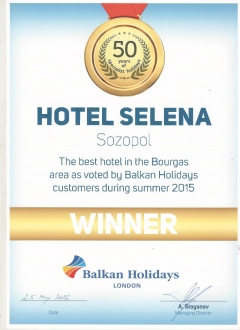Sites in Sozopol
Architectural and archaeological reserve "Old Town of Sozopol"
A Council of Ministers Decree № 320 of September 7, 1974, nominated the Old Town of Sozopol for an architectural and an archaeological reserve. Over 180 Renaissance houses in Sozopol, dating from the middle of the XVIII and beginning of XIX century, are monuments of culture. Within the reserve, there are as well a medieval church near the monastery "St. Apostles", Art Gallery, Ethnographic Collection, "St. Mary" Church, Medieval Christian Complex, the Museum at the Fortress Wall, "St. St. Cyril and Methodius" Church.
Architectural and Historical Complex "Southern Fortress Wall and Tower of Sozopol"

In Sozopol, gates are never closed
all night long a lamp lit the courtyards.
Here the streets are never the same,
and there is no need of any poets.
by Radoy Rallin "Sozopol"
In the southern part of the most beautiful town, there is a small elegant and welcoming museum complex. A restored old house of Sozopol, perched on a high, rocky coast, touched its wall to the southern fortress wall. It is one of the first private museums in the country, created by people who love Bulgaria and appreciate antiquity, knowledge and what's left from ancestors. This museum complex is "Southern Fortress Wall and Tower of Sozopol", found in 2004. There you can see the granary of V - VI century. There is one of the few completely preserved wells of ancient Apollonia Pontica and Bulgarian Black Sea coast from IV - III century BC. There is a restored part of the south wall; also one of the largest defence towers served a city to the fourteenth century and preserved chapel dating from XIII - XIV century. Moreover, you can get acquainted with historical and archaeological facts and details that make this museum complex enjoyable, pleasant and memorable. The stunning view of the southern bay and the quiet blue sea invoke unforgettable memories that remind the visitors to return often to this coast.
The story about the museum is interesting. The fortress wall was discovered during demolition of an old house, where a new one had to be build. So instead of workers at the site, archaeologists began working there. They found a well-preserved stretch of the south-eastern fortress wall and a rectangular watchtower. There was also a huge building used for the grain storage in V-VI century. It was the time when in Sozopol was the largest Black Sea Port for grain exports. That was the only barn from that period discovered in the country, containing 12 pitos (huge jugs) for corn and other smaller pots used for more than thousand years. Over granary, there were barracks where guards lived and patrolled the fortified towers. Archaeologists also found an ancient well, built in the period of IV-III century BC.
Address: Sozopol 8130, 50 Milet Street
Phone Number: +359 550 22 267
Mobile Phone Number: +359 894 568 521
"St. Mary" Church (XV century) The church is in the northern part of the old town, to the left of the main street in the east direction. It was built in the XV century on the site of an early medieval Christian church. There is data about its existence since 1482.
The church is in the northern part of the old town, to the left of the main street in the east direction. It was built in the XV century on the site of an early medieval Christian church. There is data about its existence since 1482.
The church is dug into the ground. Its east wall is on the level of the passing street and is almost indistinguishable from a house. Its last rebuilding was during Ottoman Rule. During that time, Christian churches had to be of a certain height.
to be of a certain height.
The decoration of the interior is due to the finely carved iconostasis, pulpit and bishop are thrones, with an excellent woodcarving. These carvings are the work of masters from Debar school, made at the end of the XVIII century. The icons are the work of Strandzha masters. As by the dates of some of the icons - of "St. Mary" (1781) and "St. Spiridon" (1782) it is evident that they were painted in the late XVIII century.
Archaeological Museum
 The Archaeological Museum of Sozopol is in the old part of Sozopol. The museum itself is in the building of "St. St. Cyril and Methodius" Church, as well as in some halls of the cultural centre of the town of Sozopol.
The Archaeological Museum of Sozopol is in the old part of Sozopol. The museum itself is in the building of "St. St. Cyril and Methodius" Church, as well as in some halls of the cultural centre of the town of Sozopol.
The Archaeological Museum presents the history and the thousand year cultural tradition of the town of Sozopol- from the end of VI century BC to XVII century AD. The most remarkable collections of stone and lead anchors, and bayonets I - II century BC, ancien - Greek painted vases - VI - V century BC and an antique and medieval amphoras - VI century BC.
The museum is organised into two fields: Archaeology (V century BC - XVII century AD) and Cristian Arts (XVII - XIX century).
The Archaeological Museum can be seen the Alabaster Casket, in which relics of St. John the Baptist had been preserved for centuries. The little box with an inscription in Greek is telling the story of the relics to St. Ivan Island. The relics of the saint were found in archaeological excavations on the island of Sv. Ivan in the summer of 2010. Today the valuable relics are often shown in other cities. Visitors can see them in "St. St. Cyril and Methodius" Church Sozopol, when they are in town.
Address: Sozopol, 2 Khan Krum Square
Phone Number: +359 550 22 226
Necropolis of Ancient Apollonia Pontica
 In the year of 620 BC, Greek settlers came from the coast of Asia - Miletus, in the place of a Thracian settlement. They based an independent Greek colony - Apollonia Pontica. Apollonia grew as an important commercial centre and port in the Black Sea. At that time, it was the largest and prosperous seaside town.
In the year of 620 BC, Greek settlers came from the coast of Asia - Miletus, in the place of a Thracian settlement. They based an independent Greek colony - Apollonia Pontica. Apollonia grew as an important commercial centre and port in the Black Sea. At that time, it was the largest and prosperous seaside town.
The necropolis of Apollonia Pontica was on a total area of about 300 acres, dating back from the V-III century BC. For the first time, it was excavated in 1946 when they found 801 graves. In 1964, it was declared as a cultural monument.
In Sozopol, gates are never closed
all night long a lamp lit the courtyards.
Here the streets are never the same,
and there is no need of any poets.
by Radoy Rallin "Sozopol"
In the southern part of the most beautiful town, there is a small elegant and welcoming museum complex. A restored old house of Sozopol, perched on a high, rocky coast, touched its wall to the southern fortress wall. It is one of the first private museums in the country, created by people who love Bulgaria and appreciate antiquity, knowledge and what's left from ancestors. This museum complex is "Southern Fortress Wall and Tower of Sozopol", found in 2004. There you can see the granary of V - VI century. There is one of the few completely preserved wells of ancient Apollonia Pontica and Bulgarian Black Sea coast from IV - III century BC. There is a restored part of the south wall; also one of the largest defence towers served a city to the fourteenth century and preserved chapel dating from XIII - XIV century. Moreover, you can get acquainted with historical and archaeological facts and details that make this museum complex enjoyable, pleasant and memorable. The stunning view of the southern bay and the quiet blue sea invoke unforgettable memories that remind the visitors to return often to this coast.
The story about the museum is interesting. The fortress wall was discovered during demolition of an old house, where a new one had to be build. So instead of workers at the site, archaeologists began working there. They found a well-preserved stretch of the south-eastern fortress wall and a rectangular watchtower. There was also a huge building used for the grain storage in V-VI century. It was the time when in Sozopol was the largest Black Sea Port for grain exports. That was the only barn from that period discovered in the country, containing 12 pitos (huge jugs) for corn and other smaller pots used for more than thousand years. Over granary, there were barracks where guards lived and patrolled the fortified towers. Archaeologists also found an ancient well, built in the period of IV-III century BC.
Address: Sozopol 8130, 50 Milet Street
Phone Number: +359 550 22 267
Mobile Phone Number: +359 894 568 521
"St. Mary" Church (XV century)
The church is dug into the ground. Its east wall is on the level of the passing street and is almost indistinguishable from a house. Its last rebuilding was during Ottoman Rule. During that time, Christian churches had
The decoration of the interior is due to the finely carved iconostasis, pulpit and bishop are thrones, with an excellent woodcarving. These carvings are the work of masters from Debar school, made at the end of the XVIII century. The icons are the work of Strandzha masters. As by the dates of some of the icons - of "St. Mary" (1781) and "St. Spiridon" (1782) it is evident that they were painted in the late XVIII century.
The Archaeological Museum presents the history and the thousand year cultural tradition of the town of Sozopol- from the end of VI century BC to XVII century AD. The most remarkable collections of stone and lead anchors, and bayonets I - II century BC, ancien - Greek painted vases - VI - V century BC and an antique and medieval amphoras - VI century BC.
The museum is organised into two fields: Archaeology (V century BC - XVII century AD) and Cristian Arts (XVII - XIX century).
The Archaeological Museum can be seen the Alabaster Casket, in which relics of St. John the Baptist had been preserved for centuries. The little box with an inscription in Greek is telling the story of the relics to St. Ivan Island. The relics of the saint were found in archaeological excavations on the island of Sv. Ivan in the summer of 2010. Today the valuable relics are often shown in other cities. Visitors can see them in "St. St. Cyril and Methodius" Church Sozopol, when they are in town.
Address: Sozopol, 2 Khan Krum Square
Phone Number: +359 550 22 226
Necropolis of Ancient Apollonia Pontica
The necropolis of Apollonia Pontica was on a total area of about 300 acres, dating back from the V-III century BC. For the first time, it was excavated in 1946 when they found 801 graves. In 1964, it was declared as a cultural monument.
- In the terrains of "Kalfata" – about 2.5 km southern of the Old Town of Sozopol
- In "Morskata Gradina" /"The Sea Garden"/
- In the terrains of "Harmanite"
- In the terrains of "Budzhaka"
Medieval Christian Complex
It is in the town centre, north of "St. George" Church between the streets "Apollo" and "St. St. Cyril and Methodius ". There are three construction periods:
- VI century - Classic basilica plan;
- From the end of XI century to the end of XIV century - With reconstruction of the basilica in a cruciform plan;
- From the end of XIV century to the beginning of XVII century. - With restoration related to the assault of the town in 1366 by Amadeus of Savoy and the establishment of Sozopol Episcopate.
At the end of XVII century, the complex is destroyed by the Turkish authorities under the pretext that it is hiding pirates
"St. George" Church (1867)
The medieval church with a basilica is in the old town of Sozopol.
There are serious grounds to a ssert that the ancient temple is the seat of the Episcopate on Sozopol from X to XVII century. The church was built on residential buildings from the classical and Hellenistic period of Apollonia, dating from V to II century BC. In the ninth century, the temple was destroyed by fire. At the end of XI century church was rebuilt and ornamented with frescoes. It was built around the monastery complex. The archaeological data and its location, connect the cult complex with the famous springs of the urban monastery "St. John". From the late XI century to the late XIV century, it was carried out a serious reconstruction and basilica plan was converted into a cruciform. By the end of XIV and the beginning of XVII century, it was implemented a new reconstruction. By the end of the XVII century, the church was destroyed by Turkish authorities and stopped functioning.
ssert that the ancient temple is the seat of the Episcopate on Sozopol from X to XVII century. The church was built on residential buildings from the classical and Hellenistic period of Apollonia, dating from V to II century BC. In the ninth century, the temple was destroyed by fire. At the end of XI century church was rebuilt and ornamented with frescoes. It was built around the monastery complex. The archaeological data and its location, connect the cult complex with the famous springs of the urban monastery "St. John". From the late XI century to the late XIV century, it was carried out a serious reconstruction and basilica plan was converted into a cruciform. By the end of XIV and the beginning of XVII century, it was implemented a new reconstruction. By the end of the XVII century, the church was destroyed by Turkish authorities and stopped functioning.
It possesses valuable icons and impressive wood-carved iconostasis;
"St. Zosim" Church (1857)
It is in the Town Park, on the foundations of an earlier medieval temple of Saint Zosim who is considered as a martyr of Sozopol. His name has great popularity in the town. On the western facade of the church, to the right of the entrance, there is a marble gravestone of ancient Apollonia Amphipolis (today near Kavala, Greece) since V century BC. The icons in the church are work of a Renaissance painter - Dimitar Sozopolchanina;
"St. St. Cyril and Methodius" Church
The work is of the architect Usta Gencho. It keeps a fine iconostasis of carved wood of the destroyed "St. John the Evangelist" Church of Sozopol in the 60s of XX century.
Natural and Archaeological Reserve Island "St. Ivan."
It is the largest of five islands in Bulgarian Black Sea coast. There are traces of the Thracian sanctuary of VII century BC. There is an ancient Greek temple, dedicated to Apollo the Healer (V century BC). There are also remains of the monastery "St. John the Baptist", and an ancient lighthouse Russian military cemetery. In 2001, the islands of St. John and St. Peter were declared as monuments of cultural and national importance.
Chapels
There are about 20 chapels, raised on the foundations of the destroyed churches during the Ottoman Rule: "Jesus Christ" - situated in the old town; "Konstantin and Elena"; "Paraskeva" - over the town beach; »St. Atanas"; "Demetrius"; "Nicholas"; "Nedelya"; "Marina"; "Resurrection".
"St. George" Church (1867)
The medieval church with a basilica is in the old town of Sozopol.
There are serious grounds to a
It possesses valuable icons and impressive wood-carved iconostasis;
"St. Zosim" Church (1857)
It is in the Town Park, on the foundations of an earlier medieval temple of Saint Zosim who is considered as a martyr of Sozopol. His name has great popularity in the town. On the western facade of the church, to the right of the entrance, there is a marble gravestone of ancient Apollonia Amphipolis (today near Kavala, Greece) since V century BC. The icons in the church are work of a Renaissance painter - Dimitar Sozopolchanina;
"St. St. Cyril and Methodius" Church
The work is of the architect Usta Gencho. It keeps a fine iconostasis of carved wood of the destroyed "St. John the Evangelist" Church of Sozopol in the 60s of XX century.
Natural and Archaeological Reserve Island "St. Ivan."
It is the largest of five islands in Bulgarian Black Sea coast. There are traces of the Thracian sanctuary of VII century BC. There is an ancient Greek temple, dedicated to Apollo the Healer (V century BC). There are also remains of the monastery "St. John the Baptist", and an ancient lighthouse Russian military cemetery. In 2001, the islands of St. John and St. Peter were declared as monuments of cultural and national importance.
Chapels
There are about 20 chapels, raised on the foundations of the destroyed churches during the Ottoman Rule: "Jesus Christ" - situated in the old town; "Konstantin and Elena"; "Paraskeva" - over the town beach; »St. Atanas"; "Demetrius"; "Nicholas"; "Nedelya"; "Marina"; "Resurrection".
Art Gallery
It is located at the end of the Old Town. It was built in 1991 and is in the building of the "Old School" - a cultural monument.
Address: 78 B Cyril and Methodius Street
Phone Number: +359 550 22 202
"Alexander Mutafov" House-Museum
The studio of a marine artist, built in 1937, it was converted after his death into a museum. It is open for visits since 1981. There are about 60 works by the artist.
Ravadinovo Castle
 3 km away from Sozopol, inland to the village of Ravadinovo, there is a fairy castle. The impressive building of the castle has a unique architecture and is built mainly of marble limestone. Seen from the air, it looks like a cross, and outside is decorated with ornaments of brass. They hang on the stone walls encased in the back side of the castle with thick ivy. The towers are decorated with copper
3 km away from Sozopol, inland to the village of Ravadinovo, there is a fairy castle. The impressive building of the castle has a unique architecture and is built mainly of marble limestone. Seen from the air, it looks like a cross, and outside is decorated with ornaments of brass. They hang on the stone walls encased in the back side of the castle with thick ivy. The towers are decorated with copper and brass. There are statues in the garden, giant wooden lanterns, birds of stone and mermaids. Visitors can enter the castle through a stone gate. Then there is an arch replica of Hadrian one in Istanbul, and behind it, there is a garden with a lake.
and brass. There are statues in the garden, giant wooden lanterns, birds of stone and mermaids. Visitors can enter the castle through a stone gate. Then there is an arch replica of Hadrian one in Istanbul, and behind it, there is a garden with a lake.
Due to the high interest in the castle, the access to the castle is for a fee, for those visitors whose curious eyes are riveted by his impressive architecture.
It is located at the end of the Old Town. It was built in 1991 and is in the building of the "Old School" - a cultural monument.
Address: 78 B Cyril and Methodius Street
Phone Number: +359 550 22 202
"Alexander Mutafov" House-Museum
The studio of a marine artist, built in 1937, it was converted after his death into a museum. It is open for visits since 1981. There are about 60 works by the artist.
Ravadinovo Castle
Due to the high interest in the castle, the access to the castle is for a fee, for those visitors whose curious eyes are riveted by his impressive architecture.
Hot offers








